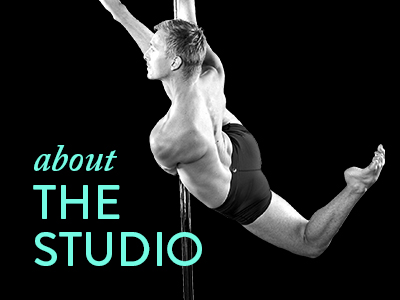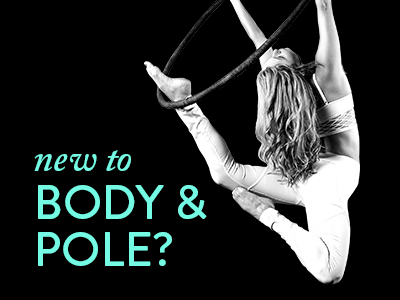We are so excited to bring you another interview with physical therapist extraordinaire Dr. Chad Woodard from SymbioPT. Dr. Chad and his team work with professional dancers and cirque performers, helping them achieve balance and longevity in their training and performance.
SymbioPT has been working with the instructors at Body & Pole in both a treatment and continuing education capacity, helping us to become more knowledgeable about keeping our students safe and injury-free. We will be continuing these conversations with Dr. Chad as part of an ongoing series about the body.
B&P: So, one area of the body we use a lot as aerialists, pole dancers, handstanders, and contortionists is our shoulders. Can you give us a cliff notes version of basic shoulder anatomy?
You are not kidding about that! You guys use your shoulders quite intensely for your sport and it’s a tricky body part. Cliff notes might end up reading like a dissertation, but ignore me when I inevitably get boring!
There are 3 major joints of the shoulder, and 1 kind of fake joint. The 3 major ones are the glenohumeral joint (ball in socket portion), as well as the sternoclavicular joint and the acromioclavicular joint (the spots where your collar bone articulates with the sternum and the shoulder blade). The fake one is the scapulothoracic joint, or the area between your shoulder blade and back of the rib cage. Reason this one is “fake” is because it isn’t really a joint like the others but it certainly has to move for you to have healthy shoulder range of motion. All four of the joints must be in good working order for a shoulder to move beautifully.
In addition to the four joints, you have about a gabillion (yes, I just said that) muscles that attach places that have effect on the shoulder and its movements. If I listed them, you’d hate me. Frankly, I’d hate me too! Better to put it this way: virtually every muscle in your chest, upper arm, neck, and back all have a direct relationship with the shoulder. It’s one of the most complicated anatomical regions of our body. For nerds like me, that makes it awesome…
But for a fun fact to use at your next cocktail party: the sternoclavicular joint (meeting point of breastbone and collar bone) is the ONLY direct bony attachment between your arm/shoulder and your trunk/ribcage. That one tiny joint is the only bony connection keeping your arm from falling off of your body!
B&P: Why is the shoulder so prone to injury?
Nice segway! Injuries happen to anatomical structures. All that anatomy stuff from before that we glossed over – yep, any and all of that can get grumpy.
What’s even better and makes the shoulder even more prone to injury is the fact of how mobile it is. Think of how much motion your shoulder has, how far it can move. It has tremendous capability for movement. Downside to that is with every bit of mobility you are allowed, you lose a bit of stability. A joint that has lots of stability is rarely injured, the exact opposite reality for the shoulder.
Movement and complexity are what make the shoulder so groovy, but those factors can also be to it’s detriment. Most of the injuries that my team and I treat are due to too much mobility of the shoulder and/or muscle imbalances.
B&P: What types of injuries can occur in the shoulder?
This can go to a scary place, one that would need a room full of puppies and rainbow glitter to pull us back…
That said, the more common injures we see with you guys is impingement (the pinching feeling at the top of the shoulder when the arm is very high overhead), rotator cuff tendonopathy (ache in the back of the shoulder), or maybe torn cartilage (labral tears).
B&P: I guess it makes sense that our shoulders are more prone to injury, because we use them so much. Is there anything we can do to prevent injury?
Better question!
Best thing you can do is to keep your shoulders balanced. Pole dancers, for example, use their lats like crazy to hold on to that pole for dear life. This results in a crazy strong lat, which is a shoulder extender and internal rotator. If my pole dancers don’t work equally hard to strengthen the opposite muscles (the ones that flex and externally rotate), there will be an imbalance. What happens with imbalance? One side wins and the other loses. That equates to pain and injury!
The B&P instructors go through training in this and can give some brilliant advice on exercises and strengthening. Listen to them!
If the problem persists, come see my team for a session of hugs and witty humor.
B&P: Ok so how about this scenario. I take class, and whomp whomp, the next day, my shoulder hurts. And it STILL hurts a week later. What should I do?
Still hurting a week later is not so bueno. Pain lasting more than a day or so can indicate something fairly gnarly is going on and needs some attention. You don’t necessarily have to take an ambulance to your nearest urgent care, but you should get it checked out. The folks that usually need us for the longest amount of time start with the following story, “my shoulder was hurting for a while but I kept working through it hoping it would go away.” We strongly prefer to see people long before disaster strikes!
B&P: Cool. Is it the end of the world if I DO injure my shoulder?
Really, no. It’s likely to happen and fixable. The only thing people do that gets them into trouble is ignoring it. Pain means your body is unhappy and needs answers. Go get them.
B&P: Now let’s say I’m cleared by my doctor/PT to take class again, can I do everything I did before with complete abandon?
Make sure to ask your PT or MD what you should and shouldn’t be doing and how to get back to your sport PROGRESSIVELY. A marathon runner who takes a year off should not start back with a 15 mile run. That’s crazy talk. Same rules apply here. If you’ve had to take some time off, get back in progressively so your body/shoulder has enough time to grow back to it’s full and happy levels of strength.
B&P: Awesome. Thanks again for taking the time to talk with us!
My team and I hold you guys in the absolute highest respect! You push your bodies to the limit for something you love, and that’s something we love! Keep doing what you do. Keep loving it. It is an honor to treat you and see you achieve your incredible goals!
SymbioPT is just around the corner from Body & Pole, located on West 29th St. between 7th and 8th Aves. To book an appointment visit www.symbiopt.com. You can follow Dr. Chad on Instagram – @askdrchad and @symbiopt.



